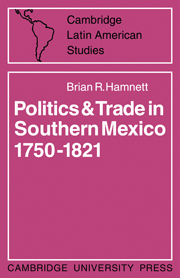Book contents
- Frontmatter
- Contents
- Acknowledgments
- Archival abbreviations
- Weights, measures, and currency
- Introduction
- 1 Oaxaca—environment and trade
- 2 The struggle for control of trade
- 3 The problem of reform, 1768–1786
- 4 Reform and reality—the crisis of the subdelegations in the 1790s
- 5 The Gálvez Plan under fire, 1786–1804
- 6 Finance, trade, and the merchants, 1789–1808
- 7 The political crisis of 1808–1821
- 8 Conclusion—Oaxaca within the context of Mexican politics
- Glossary of Personnel
- Appendices
- Sources and bibliography
- Maps
- Index
1 - Oaxaca—environment and trade
Published online by Cambridge University Press: 04 August 2010
- Frontmatter
- Contents
- Acknowledgments
- Archival abbreviations
- Weights, measures, and currency
- Introduction
- 1 Oaxaca—environment and trade
- 2 The struggle for control of trade
- 3 The problem of reform, 1768–1786
- 4 Reform and reality—the crisis of the subdelegations in the 1790s
- 5 The Gálvez Plan under fire, 1786–1804
- 6 Finance, trade, and the merchants, 1789–1808
- 7 The political crisis of 1808–1821
- 8 Conclusion—Oaxaca within the context of Mexican politics
- Glossary of Personnel
- Appendices
- Sources and bibliography
- Maps
- Index
Summary
During the course of the first century after the Conquest, the dye trade of Oaxaca secured a position in New Spain's export trade second only to that of silver. The scarlet cochineal dye, produced almost exclusively by the Indian population, maintained this role until well into the nineteenth century, when competition from Guatemala after 1821, and the invention of chemical dyes after the 1850s combined with the effects of the wars of Independence after 1810 to damage the Oaxaca economy to the degree that the indigenous dye trade was practically eliminated.
Prior to the discovery of the Mexican-Indian cochineal, the chief source for the scarlet dye had been the kermes insect, which had thrived in the Mediterranean basin, and had provided the European powers with their needs. The entrepôt had been Venice. However, the exploitation of the Mexican dye, produced in the early years in Tlaxcala, Huejotzingo, and Cholula, as well as Oaxaca, put on the world market a dye with ten or twelve times the propensities of the kermes. The first shipment of the Tlaxcala–Oaxaca dye into Spain occurred in 1526, and by the late 1540s cochineal was being sold in quantity in the market of Tlaxcala. In response, the local cabildo (municipal council) sought to encourage plantation of nopaleras, the cactus groves on which the cochineal insect throve. By the middle of the sixteenth century, Tlaxcala's Indians were reputed to be earning over 100,000 ducados annually from their dye sales.
- Type
- Chapter
- Information
- Politics and Trade in Mexico 1750–1821 , pp. 9 - 23Publisher: Cambridge University PressPrint publication year: 1971



